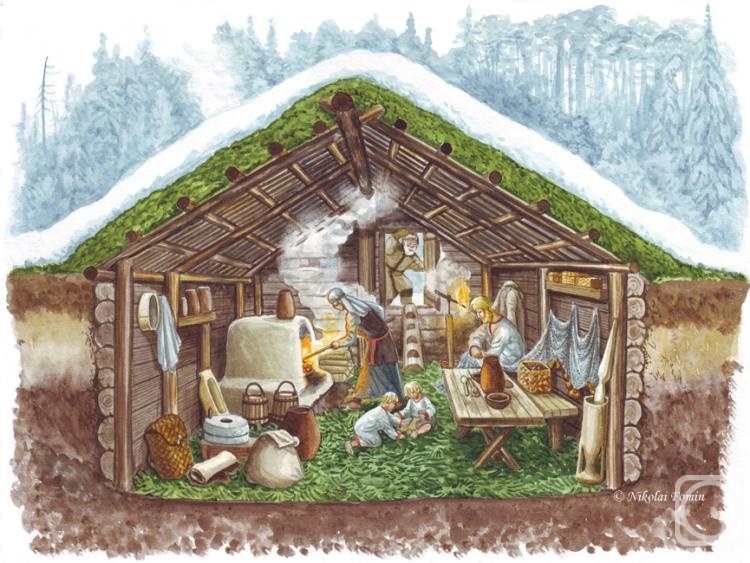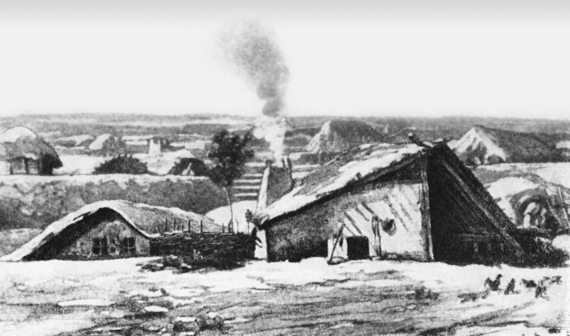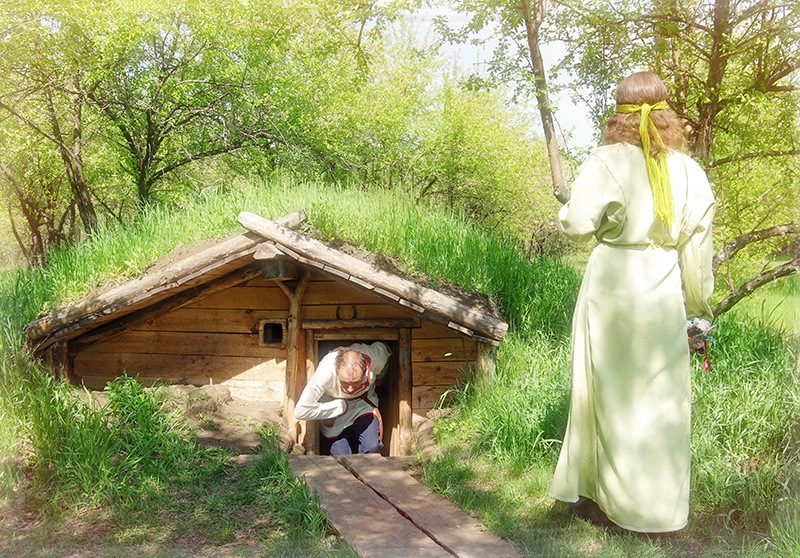An alternative story already? Figures taken from the sky.
By whom? By Mongols, who made their calculations and used it to calculate tribute? Very possible, but then we don't have any solid data for russian population, because, I believe, the next panRussian census was made quite later, and therefore I again asking you how do you make your numbers. My method is quite simple - taking estimated urban population, considering 15% urbanization (quite a radical estimate - actually, for lands like Ukraine it would be like 5%), therefore numbers would came. Still, of course, any numbering of populations without solid archeological or demographic data would be taken from the sky and heavily depend from methodology.
Take Vernadsky. His (actually, slighly conservated Milukov's one) method (methods) is following:
1. Peter's census (well, not exactly census but taxpayers revisions, so nothing really solid) shown about 15 millions for 1725. If you want to see how this numbering done, please, don't limit yourself with Wiki, it's very vague about it, and actually saying more about revision on 1722, showing 5 millions; as you can read even there, it's not even nearly correct. Adding Polish and Lithuanian sources, we can add 2 millions more. Therefore, being very conservative, we can safely assume total population of Russia being about 12 millions in 16th century.
2. Still, keep in mind that we're saying about disaster times. Peter keep constant wars. Alexey had Razin insurrection. Beginning of 16th century called "Time of Troubles" for the reason. Earlier there were, well, mongols themselves and plague of 14th century. Meaning that we can't avait drastic growth of population there, until we can't define some factor.
3. Therefore, for XII century we can safely assume 7-8 millions for XII century as a conservative assumption.
That's conform mongolian data, and, as you can see, it wasn't used for this calculation.
Also. Estimated total urban population in XII century is about a million. If we believe in 7 million population, it's 13% urbanization; for agrarian society it's astonishing number. For the reference: urbanization of Russian Empire in
1914 was 18%, including western governorships.
And if you take in mind that Kiev was a most priviliged prince seat, the center of Russian land until mongol devastation, it's highly unlikely it was the least populated.
The Russian army never numbered 430 thousand people.
No, it never was. So? It wasn't russian administrative division, but Mongolian one.
That is, that the lands of Ukraine/Belarus/Russia were too sparsely populated to explain all the Slavs spreading across half of Europe.
Well, yes. That's the problem of
Avar theory, not Dnieper one, as I write several times before.
In "my" (actually, I'm just repeating textbooks) theory this spreading took about one-and-half thousand years, happening on par with Germanic and Turkic movements (which took a lot of attention; by the way, Scandinavia never was a dense populated region, still Germans were able to spread across the other half of Europe), in the time of climate change. As it's impossible (rrrrright?) to refuse half of Europe being spread by Slavs to 9th-10th century, this slavs should be spread from somewhere. Until real ruler of Avars wasn't Saruman, who breed slavs as orks, I can't see how it's possible in 3 centuries. Especially if we proclaim Balkans being sparsely populated as well, so they didn't came from there, and baltic lands never were megapolis lands as well.
According to Aono, the Slavs, having just freed themselves from the oppression of the Goths, went to conquer distant lands. Which had plenty of free land and wildlife. For certain death in the fight against the strong Roman Empire.
Nope. According to me, "Slavs" (meaning people who speak on some dialect of panbaltic language, splitting from general baltic group somewhere on a road) and carried r1a1 haplogroup with southern contamination, opposing baltic northern contamination; I'm going to use term "protoslavs"), slowly spreaded, under different names in civilized neighbourhood chronicles (as they hadn't genetics or even comparatible antropology, I'm not scolding ancestors for such a negligence), for, like, one-and-half thousand years. They already were spread when Goths came, they were subjects in Goth empire.
Their problem was that they hadn't Roman (and other civilized) tech for agriculture, so their areals couldn't support big populations - it was slash-and-burn. Still, they lived in nice places, so their death rate wasn't high (of course, everything is relative, and in modern sense their death rate was astonishing). Therefore, as they couldn't really feed big cities, their groups split out and go by river dales to the south from their basic lands (that's to Balkans), to the west (to Poland, Bohemia, Prussia), and to the north (to Northern Russia), pushing balts and finns out or assimilating them. Wildlife wasn't exactly a civilization problem for
Homo Sapiens Sapiens for a long, long time (humans can really solve wildlife problem on the very early stage of their development, even if some groups wouldn't be able to survive), and free land wasn't a problem, it was a desired feature. Low population density, low tech level and culture overlap from conquerers prevented unified archeological culture until 5-7 century. Constant moving around supported linguistical unity.
They had two greatest problems.
1. Slash-and-burn agriculture requires to move around. You can take nice harvests from the same plot of earth for 3, maybe 6 years, and then you'll need to wait about 50 years until land would restore. So they weren't afraid of free land, free land was a gift of heavens. Happily, there was a lot of free lands in Eastern Europe.
2. Still, they could exist for the time, and coexist with a lot of local population, paying whoever came and wanted something, until climatic pessimum of earliest medieval happened. Traditional lands stopped to give harvests. You see, the characteristic feature of agrarian society is that they very fast can get into the maximum population their land can allow, and then they would stay stable for centuries. For the protoslavs, climatic pessimum was a disaster (actually, it wasn't neat for anybody). Their agricultural techniques never were very effective in a first place, and climat getting more cold... yeah. So they started to push south. They wasn't think, like, "hey, there is a scary Roman Empire!" - they had a choice, going west/south, or die hungry. People tend to take first approach.
So they came south in a mass. Imagine Ukraine being able to support 300 000 men in good climatic moment; so when climat dropped, it was a half of this number going out (another half stayed where they were). They gang, because, well, they were tribal, but they weren't stupid (I hope I don't need to point how such a ganging forms in history). That's what Byzantium sources seen as "slavic invasions" on Balkans.
If Roman Empire were strong, well, they would be repelled. Thing is, Roman Empire wasn't strong. They had climatic pessimum as well, meaning depopulation of the factor of
4, for crying out loud, they had constant wars on every border, internal strife and barbarian invasions. So protoslavs were able to stick on borders. And this gave them the best thing it could - roman agriculture tech. Of course, it wasn't gene-modified crops and nutriented many-field systems, but it was highly better then things protoslavs had. At this point, we have slavs in written history. Ethnogenesis finished.
Sorry for being poetic, but if germanic invasions were a trauma, slav colonization was like an an illness. As free space, where some group of non-developed people can came and start to harvest something, maybe evicting locals in process (because it's not very easy to stop it without areal patrols; or, at least, big walls with constant patrols). Any point of weakness in established centralized space - hop, slavs are here. Not many of them, sure; but, as I already pointed, agrarian societies tends to grow fast, and their seminomadic agricultural technique means every such a spot would be a secondary center of slavic colonization - and keep in mind that primary center wasn't depopulated, so it would give new waves. As this people never declared themselves masters of the land, no invader seen a need for genocide them, and even when he somehow did, well, such killed group would be fastly replaced. But what invaders did - they destroyed local power structure, leaving slavs. Continuing illness anagolue - when an animal died from carnial trauma (germanic or turkic invasion), bacteria in corpse would thrive.
So it goes.







